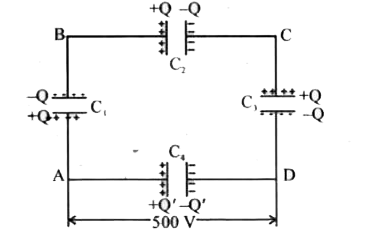A network of four 10μF capacitors is connected to a 500 V supply, as shown in figure. Determine (a) the equivalent capacitance of the network and (b) the charge on each capcitor.
 Solution in Tamil
Solution in Tamil
(a) In the given network, C1,C2 and C3 are connected in series. The effective capacitance C. of these three capacitors is given by
1C.=1C1+1C2+1C3
For C1=C2=C3=10μF,C.=(10/3)μF.The network has C′ and C4 connected in parallel. Thus, the equivalent capacitance C of the network is
C=C.+C4=(103+10)μF=13.3μF
(b) Clearly, from the figure, the charge on each of the capacitors, C1,C2 and C3 is the same, say Q, Let the charge on C4 be Q.. Now, since the potential difference across AB is Q/C1. across BC is Q/C2, across CD is Q/C3,we have
QC1+QC2+QC3=500V
Also, Q./C4=500V
This gives for the given value of the capacitances.
Q=500V×103μF=1.7×10−3 C and Q.=500V×10μF=5.0×10−3 C
Topper's Solved these Questions
- ELECTROSTATIC POTENTIAL AND CAPACITANCE BOOK - NCERT TAMILCHAPTER - ELECTROSTATIC POTENTIAL AND CAPACITANCE EXERCISE - EXERCISES
35 Videos
- ELECTROSTATIC POTENTIAL AND CAPACITANCE BOOK - NCERT TAMILCHAPTER - ELECTROSTATIC POTENTIAL AND CAPACITANCE EXERCISE - ADDITIONAL EXERCISES
1 Videos
- ELECTROMAGNETIC WAVESBOOK - NCERT TAMILCHAPTER - ELECTROMAGNETIC WAVESEXERCISE - Evaluation (Numerical problems)
5 Videos
- ELECTROSTATICSBOOK - NCERT TAMILCHAPTER - ELECTROSTATICSEXERCISE - Exercises
23 Videos
Similar Questions
Two charges n 5×10−8Cand−3×10−8C are located 16 cm apart. At what points on the line joining the two charges is the electric potential zero ? Take the potential at infinity to be zero.
View SolutionA charge of 8 mC is located at the origin. Calculate the work done in taking a small charge of −2×10−9C from a point P (0,0,3 cm) to a point Q (0,4 cm, 0) via a point R (0,6 cm, 9cm).
View SolutionConsider a parallel plate capacitor whose plates are closely spaced. Let R be the radius of the plates and the current in the wire connected to the plates is 5 A, calculate the displacement current through the surface passing between the plates by directly calculating the rate of change of flux of electric field through the surface.
View SolutionWhen two objects are rubbed with each other, approximately a charge of 50 nC can be produced in each object. Calculate the number of electrons that must be transferred to produce this charge.
View SolutionA network of four 10μF capacitors is connected to a 500V supply as shown in Fig. Determine the (a) equivalent capacitance of the network and (b) charge on each capacitor.

View SolutionA network of four each of 12 mu F capacitance is connected to a 500 V apply as shown in Fig. (a) Equivalent capacitance of the network. (b) Charge on each capacitor.
View SolutionA network of four 10 mu F capacitors is connected to a 500 V supply, as shown in Fig. Determine (a) the equivalent capacitance of the network and (b) the charge on each capacitor. (Note, the charge on a capacitor is the charge on the plate with higher potential, equal and opposite to the charge on the plate with lower potential.)
View SolutionA network of four capacitors each of 15μF four capacitors each of the μF capacitance is connected to a 500 V supply as shown in the figure . Determine (a) equivalent capacitance of the network and (b) charge on each capacitor .
View SolutionA network of four 20 μF capacitors is connected to a 600 V supply as shown in the figure.
The equivalent capacitance of the network is

View Solutionचित्र में दर्शाए अनुसार 10μF के चार संधारित्रों के किसी नेटवर्क को 500 V के स्त्रोत्र से संयोजित किया गया है, नेटवर्क की तुल्य धारिता
View SolutionA network of four 10μF capacitors is connected to a 500 V supply, as shown in figure. Determine (a) the equivalent capacitance of the network and (b) the charge on each capcitor.

View SolutionA network of four 10μF capacitors is connected to a 500 V supply as shown in figure. Determine (a) the equivalent capacitance of the network and (b) the charge on each capacitor.

View SolutionA network of four 10μF capacitors is connected to a 500 V supply, as shown in Fig. Determine (a) the equivalent capacitance of the network and (b) the charge on each capacitor. (Note, the charge on a capacitor is the charge on the plate with higher potential, equal and opposite to the charge on the plate with lower potential.)

View SolutionA network of four capacitors each of 12 μF capacitance is connected to a 500 V supply as shown in the Fig .

Determine equivalent capacitance of the network .
View SolutionA network of four capacitors each of 12 μF capacitance is connected to a 500 V supply as shown in the Fig .

Determine charge on each capacitor .
View SolutionA network of four each of 12μF capacitance is connected to a 500V apply as shown in Fig.

(a) Equivalent capacitance of the network.
(b) Charge on each capacitor.
View Solution
